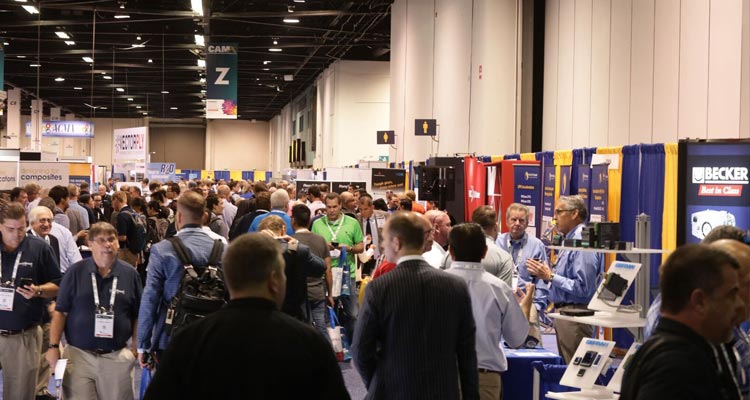It was abundantly clear walking around the CAMX exhibit hall that many companies are, indeed, embracing manufacturing 4.0. Here are just a few of the solutions showcased on the floor:
- Toolless Thermoplastic Parts: Mikrosam displayed a proof-of-concept toolless thermoplastic manufacturing process that uses dual robots to create thermoplastic parts without a mandrel. One robot lays up thermoplastic tapes using controlled angles, while a second follows the same path on the opposite side of the part to maintain its shape.
- Automated Patch Placement with Self-Corrective Quality Control: Cevotec’s new patch placement system is designed to help aerospace manufacturers automate. By placing different materials on complex surfaces – such as adhesives and prepreg glass fiber on honeycomb – the system can replace hand lay-up. It also uses cameras to check quality at multiple production points and correct any problems in real time.
- Fully-Automated Hydraulic Presses: Langzauner’s hydraulic presses help customers meet short cycle times through automated mold changing. Traditionally, changing molds – especially hot ones – is a time-consuming task that can take up an entire shift, while Langzauner’s automated process can do it in 15 minutes, according to the company.
- Trainable Robot for Spray Lay-Up: CAMX attendees gathered around the Composites One demonstration area to watch MVP demonstrate a new spray lay-up robot that can be taught without programming. The teachable, automated sprayer is currently used to manufacture boats, pools and other products.
Global Trends to Keep an Eye On
The way people and cargo move from place to place is rapidly changing, and there are overarching global transportation megatrends impacting societies and economies. At CAMX 2019, several of these global megatrends were discussed at educational sessions, on the exhibit hall floor and among conversations at networking events.
One such trend is electric vehicles (EVs), which are beginning to experience unprecedented growth that will continue through 2040, according to Nick Albanese, research associate on the advanced transport team at Bloomberg New Energy Finance (NEW). One of the panelists on an educational session on the future of ground transportation, Albanese said that while electric vehicles still represent only 2 to 4% of the automotive market, annual sales doubled in 2018 and will reach 2 million to 3 million in 2019, putting 5 million EVs on the road. “There are very few industries where you go from zero to five million this quickly,” he noted. Albanese said that rapid acceleration will continue due to three key trends: reduced battery pack costs, commitment by automakers to electrification and government incentives and mandates, notably those in China.
Within the automotive sector, composites companies should also keep an eye on shared mobility, where users access cars on an as-needed basis. While ridesharing through companies such as Uber and Lyft are beginning to boom, other shared mobility models will continue to develop, said Dale Brosius, chief commercialization officer of IACMI—The Composites Institute and moderator of the ground transportation session. “The average privately owned vehicle is used about 4% of any 24-hour period,” he said. “The rest of the time it just sits.” Brosius noted that this provides additional opportunities for sharing, as owners increasingly offer their private vehicles for use by others.
Another transportation megatrend on the horizon is urban air mobility (UAM). As more people continue to migrate to cities and populations grow, urban air mobility (UAM) has generated buzz for its ability to alleviate congestion and efficiently transport people and cargo. At the CAMX featured session, “Urban Air Mobility – City Infrastructure Design and the Promise of Composites,” Michael Dyment of NEXA Capital Partners shared an overview of UAM and its potential for the composites industry.
The market size for urban air mobility is close to $2 trillion, said Dyment, whose firm conducted an economic study examining the potential for UAM. “There are over 200 companies or projects today designing vehicles,” he said. “They are heavily oriented toward composites because they need to be very lightweight, super strong and capable of performing in really tough conditions.”
Whether on the ground or in the air, the transportation market will be impacted by even larger trends. “To set the stage for where the [composites] market is going in terms of changes in the transportation industry, we have to frame it all in the new paradigm of mobility, autonomy and electrification,” said Brosius.


